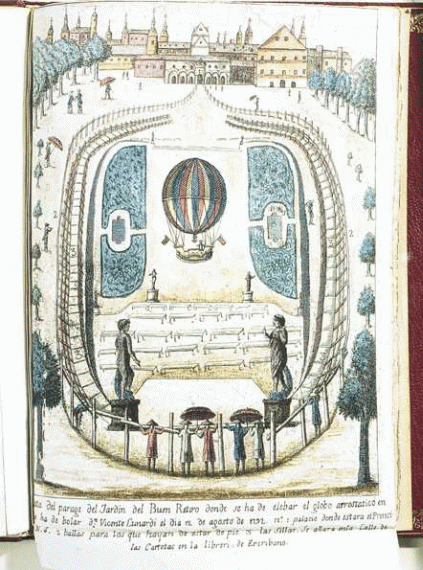
ha executado desde esta corte al lugar de daganzos de arriba en el globo aerostatico : que para este efecto se le preparo en el real sitio del Buen Retiro el dia 12 de Agosto de 1792. [Robinson 281, Robinson (Marjorie and Philip) Collection]
The note written in Spanish underneath describes the above image, where Vincente Lunardi is riding in a colourful balloon ascending (going upwards) from the Jardin del Buen Retiro (the public garden) in Madrid on 12th August 1792.
Vincente Lunardi was born in Lucca in Italy in 1759. He was an Italian aeronaut, which is someone who travels in an airship or balloon. He gained fame for the first 24 mile hot air balloon flight in England.
In the late 18th century (1700’s) there was a flying craze. There was the first manned free floating balloon flight in France (November 1783) and the first manned, free floating ascent in Scotland by James Tytler (August 1784).
Lunardi’s flight took off from the Honourable Artillery Company ground (an area that contained large weapons) at Moorfields in London. The flight occurred in September 1784 and many gathered at the grounds to watch it. It is claimed that he had to leave his friend, George Biggin behind, due to the crowd’s growing impatience or due to the balloon not inflating enough. Sources state that he had a cat, a dog and a pigeon with him for company. His balloon was very brightly decorated and was inflated by hydrogen gas to make it light enough to fly. He travelled for a total of 24 miles across London and overshadowed James Tytler’s balloon ascent, where he only went upwards from the ground.
Lunardi was nicknamed the ‘Daredevil Aeronaut’ and inspired ladies’ skirts and hats. The ‘Lunardi bonnet’ (a bonnet is a type of hat) is mentioned in a poem by the famous poet Robert Burns called ‘To a Louse’.
He carried out several more balloon flights, including one at the Jardin del Buen Retiro in Madrid in 1792. This was his first air balloon attempt in Spain. Prince Ferdinand of Spain was amongst the people watching and wasn’t very impressed as the balloon rose 300 metres from the ground before falling in the town of Daganzo de Arriba.
This text is originally taken from the Education Outreach team’s ‘Amazing Archives’ resource.
